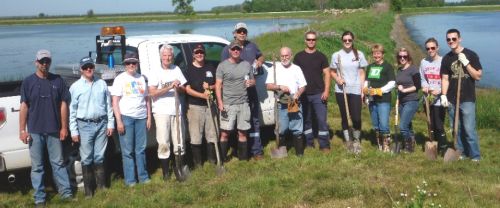Communities lend a helping hand in Lambton Shores

St. Clair Region Conservation Authority (SCRCA) staff have been busy over the last year meeting with landowners to discuss opportunities to further a healthy Lake Huron. It is clear that Lambton Shores residents want to improve water quality to ensure their beaches remain healthy and a vibrant part of the community.
Here are a few highlights:
- Postcards were mailed to shoreline and rurallandowners in Lambton Shores, reminding them of the grants available for stewardship projects. We sent out more than 1,300 postcards!
-
Working with CH2M Hill, the local Communities in Bloom group, the Municipality of Lambton Shores and the Lambton Shores Trail Group, the St. Clair Region Conservation Authority has been planting wetland plants, shrubs and trees to restore the retired forest sewage lagoons. Funding for this project came from CH2M Hill and TD Friends of the Environment Foundation.
- The SCRCA display at the three-day Forest Fall Fair showcased some of the animals that live in local watersheds, like the endangered EasternFoxsnake, Snapping Turtles, a number of minnow species, and Freshwater Shrimp. This was an opportunity to meet with families and promote stewardship grants that support healthy natural areas.
- SCRCA partnered with a local landowner who was interested in determining if his farming practices influenced phosphorus levels leaving his fields. He compared nutrient levels in water samples collected from two outlets of a winter wheat field and one outlet from a field using conventional tillage with bean stubble.
While this was a very limited sample, it was interesting to note that the conventionally tilled field water sample contained three-times more phosphorus and nitrogen and two-times more dissolved solids than the water sample from the cover crop field.
In Lambton Shores, cover crops are worth it!
- We circulated a fact sheet about cover crops to local farmers and had a great discussion about these findings at the Lambton Soil and Crop Improvement Association meeting.
- Students from Hillside School at Chippewas of Kettle and Stony Point First Nation went wading in Shashawandah Creek to use dip nets, turn over rocks, and check minnow traps to find aquatic bugs and fish. SCRCA staff talked about the life cycles and biology of these species and how they can be used to monitor the health of a stream.
- On a cold, windy November day, SCRCA staff planted more than 1,000 native dune grass plugs in C.J. McKewen Conservation Area. The dune rehabilitation project was supported with funding from the Ontario Ministry of the Environment and Climate Change. Dune-grass roots help secure sand on the beach and reduce erosion by wind and water.
